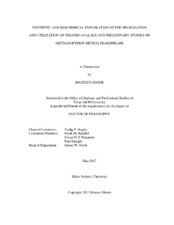| dc.contributor.advisor | Begley, Tadhg P | |
| dc.creator | Shome, Brateen | |
| dc.date.accessioned | 2019-03-07T15:52:08Z | |
| dc.date.available | 2019-05-01T06:10:06Z | |
| dc.date.created | 2017-05 | |
| dc.date.issued | 2017-01-13 | |
| dc.date.submitted | May 2017 | |
| dc.identifier.uri | https://hdl.handle.net/1969.1/174894 | |
| dc.description.abstract | Thiaminase I from Clostridium botulinum cleaves thiamin to the constituent pyrimidine and thiazole using a wide range of external nucleophiles. The crystal structure of the thiamin bound mutant of thiaminase I from Clostridium botulinum revealed the complete active site architecture and all the catalytically important residues were identified. The role of each active site residue was determined by its position and the steady-state kinetic study of the mutant of the corresponding residue. Based on the structural and the kinetic data, the mechanism of thiaminase I is proposed. Thiaminase I accepts a wide variety of cysteine containing nucleophiles, suggesting the possibility of some protein or peptide as its natural nucleophile. A plate assay and an HPLC based assay were developed to identify new thiaminase producing bacteria.
The second part of the thesis is focused on the development of synthetic strategies for thiamin analogs to answer the following biological questions. Firstly, methoxythiamin pyrophosphate synthesized to study the effect of bacimethrin on thiamin-dependent enzymes and ^13C and ^15N labeled thiamin analog was synthesized to study different intermediate states of thiamin in PDC. Inhibition of thiamin-dependent enzymes was observed and the data indicates that the toxicity arises due to a different binding mode of 2’-methoxythiamin in the active site. Secondly, two fluorine labeled thiamin analogs were designed that can be used as a tracer for PET imaging study in live animals. Thirdly, synthetic methodologies have been developed to utilize thiamin molecule as a delivery vehicle. The impermeable cargo molecules attached to thiamin molecule via ester or carbamate linkage can be delivered inside the cells through membrane transporters of thiamin. Finally, synthesis of thiochrome was utilized to estimate thiamin content in auxotrophic phytoplankton and preferential utilization of pyrimidine precursors were observed to fulfill the thiamin requirement.
Preliminary studies were done to explore a putative methanopterin methyltransferase MJ0619. This enzyme is air sensitive and copurifies with bound 4Fe- 4S clusters. MJ0619 contains at least three 4Fe-4S clusters and can cleave SAM homolytically in reducing conditions, which classifies it as a radical SAM enzyme. It also possesses GTP cyclohydrolase activity to produce 7,8-dihydroneopterin cyclic phosphate from GTP and can cleave N-glycosidic bond of several nucleosides. Methylation of 7,8- dihydro-6-hydroxymethyl pterin is also observed with this enzyme, however the sources of the methyl groups are still unknown. | en |
| dc.format.mimetype | application/pdf | |
| dc.language.iso | en | |
| dc.subject | Thiamin | en |
| dc.subject | Thiaminase | en |
| dc.subject | Bacimethrin | en |
| dc.subject | PET Imaging | en |
| dc.subject | Fluorine labeled Thiamin | en |
| dc.subject | Cargo Delivery | en |
| dc.subject | Thiochrome | en |
| dc.subject | Thiamin estimation in Haptophytes | en |
| dc.subject | Methanopterin | en |
| dc.subject | Radical SAM | en |
| dc.subject | GTP Cyclohydrolase | en |
| dc.subject | Methyltransferase | en |
| dc.title | Synthetic and Biochemical Exploration of the Degradation and Utilization of Thiamin Analogs and Preliminary Studies on Methanopterin methyltransferase | en |
| dc.type | Thesis | en |
| thesis.degree.department | Chemistry | en |
| thesis.degree.discipline | Chemistry | en |
| thesis.degree.grantor | Texas A & M University | en |
| thesis.degree.name | Doctor of Philosophy | en |
| thesis.degree.level | Doctoral | en |
| dc.contributor.committeeMember | Raushel, Frank M | |
| dc.contributor.committeeMember | Watanabe, Coran MH | |
| dc.contributor.committeeMember | Straight, Paul | |
| dc.type.material | text | en |
| dc.date.updated | 2019-03-07T15:52:08Z | |
| local.embargo.terms | 2019-05-01 | |
| local.etdauthor.orcid | 0000-0001-6656-6232 | |


